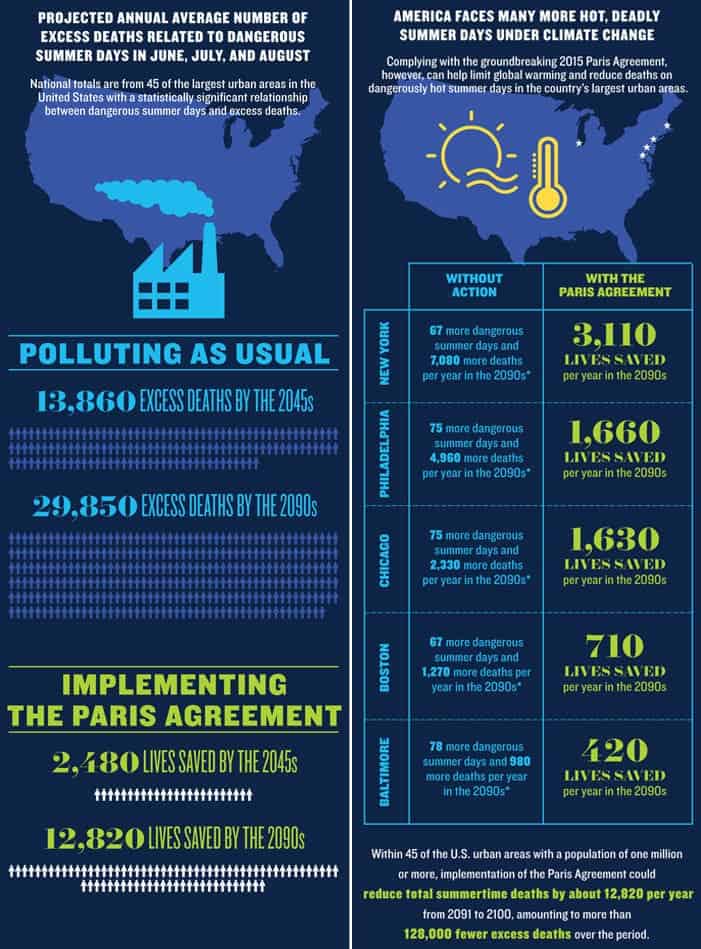According to a new analysis performed by the Natural Resources Defense Council, failure to limit emissions might cost the lives of more than 13,000 Americans every year by the mid 2040s and more than double that number by 2090.

From agricultural breakdown to rising ocean levels, climate change will drastically change our world and our place in it. But its effects always feel like they’ll take place somewhere else, don’t they? The ocean’s far away, and farms are a pretty rare sight these days. One effect, however, will hit everywhere, cities in particular, and will enact a massive toll of human lives — scorching summer heat.
“If we continue to emit climate-changing pollution at our current rate, our largest urban areas like New York, Philadelphia, and St. Louis will see many more summertime deaths,” the Natural Resources Defense Council’s (NRDC) report reads.
Deadly hot
Heatwaves can lead to a number of dangerous, potentially fatal health conditions, such as heatstroke, cardiovascular, and respiratory disorders. Children and the elderly are particularly at risk, as are low-income families who can’t afford to cool their homes or (largely thanks to the Don’T Care Act) seek medical help from heat-associated symptoms.
The paper estimates that for 45 of the US’ largest urban centers alone, heat-related fatalities could total 13,860 every year by the mid-2040s — that’s roughly 150 deaths, every day, for the whole summer. By 2090, that figure could increase to a staggering 30,000 per year, or more than 300 deaths every day of summer.
The 2090 estimates show that heat waves could kill 7,370 people per year in New York on average, 5,040 in Philadelphia, 2,440 in Chicago and 1,340 in Boston. Juanita Constible, the NRDC’s special projects director and author of the report, said that the analysis shows “some of the most dire consequences” of where current US policy is leading the country.
“The Trump administration is doing everything it can right now to roll back climate and health protections,” she said.
“Instead of accelerating our nation’s transition to a cleaner, safer future, President Trump and his Cabinet are driving in reverse with their eyes closed.”

The best way to put these figures into context is by looking at past statistics. Between 2006 and 2010, the Centers for Disease Control and Prevention reports, there were about 620 reported cases of heat-related deaths. In the entire US.
Constible also estimates that if countries around the world meet their Paris goals, some 12,820 lives could be saved each year in the largest 45 metropolitan areas, the NRDC estimates — more than 3,100 in New York alone, and around 1,600 in both Philadelphia and Chicago.
But again, that’s contingent on the goals agreed upon in Paris, which aim to keep global warming below 2 degrees Celsius, being met. With the US’ recently announced withdrawal from the agreement, one of the largest emitters in the world doesn’t seem interested in pursuing that goal any longer. At the same time, Americans will likely have to deal with both more frequent, and more intense heatwaves, as well as a more polluted and dangerous environment: President Trump has promised to save America’s dying coal industry, and increase oil and gas production, and is set to gut the Environmental Protection Agency’s funding for climate programs.
“To minimize needless and preventable American deaths from heat-related causes, the Trump administration must cease these rollbacks of vital health and environmental protections and immediately recommit to the Paris Agreement,” the report concludes.
You can read and download the full report here, via NRDC.


